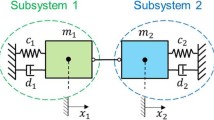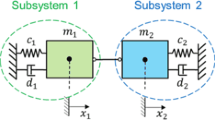Abstract
Based on the stabilized index-2 formulation for multibody systems, a semi-implicit co-simulation approach for solver coupling with algebraic constraints has been presented by Schweizer and Lu (Multibody Syst. Dyn., 2014) for the case that constant approximation is used for extrapolating/interpolating the coupling variables. In the manuscript at hand, this method is generalized to the case that higher-order approximation is employed. Direct application of higher-order polynomials for extrapolating/interpolating the coupling variables fails. Using linear approximation polynomials, artificial oscillations in the Lagrange multipliers of the kinematical differential equations are observed. For quadratic and higher-order polynomials, the co-simulation becomes unstable. In this work, the key idea to obtain stable solutions without artificial oscillations is to apply a relaxation technique. A detailed stability and convergence analysis is presented in the paper for the case of higher-order approximation. In this context, the influence of the relaxation parameter on the stability and convergence behavior is investigated. Applicability and robustness of the stabilized index-2 co-simulation method incorporating higher-order approximation polynomials is demonstrated with different numerical examples. Using piecewise constant approximation polynomials for the coupling variables produces discontinuous accelerations and reaction forces in the subsystems at the macrotime points, which may entail problems for the subsystem integrator. With higher-order approximation polynomials, the coupling variables and in consequence the accelerations and reaction forces in the subsystems become continuous.















Similar content being viewed by others
References
Ambrosio, J., Pombo, J., Rauter, F., Pereira, M.: A memory based communication in the co-simulation of multibody and finite element codes for pantograph-catenary interaction simulation. In: Bottasso, C.L. (ed.) Multibody Dynamics: Computational Methods and Applications, pp. 231–252. Springer, Berlin (2009)
Ambrosio, J., Pombo, J., Pereira, M., Antunes, P., Mosca, A.: A computational procedure for the dynamic analysis of the catenary-pantograph interaction in high-speed trains. J. Theor. Appl. Mech. 50(3), 681–699 (2012)
Anderson, K.S.: An order-\(n\) formulation for the motion simulation of general multi-rigid-body tree systems. Comput. Struct. 46(3), 547–559 (1993)
Anderson, K., Duan, S.: A hybrid parallelizable low-order algorithm for dynamics of multi-rigid-body systems: Part I, Chain systems. Math. Comput. Model. 30(9–10), 193–215 (1999)
Arnold, M.: Numerical methods for simulation in applied dynamics. In: Arnold, M., Schiehlen, W. (eds.) Simulation Techniques for Applied Dynamics. Springer, Berlin (2009)
Arnold, M., Clauss, C., Schierz, T.: Error analysis and error estimates for co-simulation in FMI for model exchange and co-simulation in V2.0. Arch. Mech. Eng. 60(1), 75–94 (2013)
Busch, M., Schweizer, B.: Numerical stability and accuracy of different co-simulation techniques: Analytical investigations based on a 2-DOF test model. In: Proceedings of the 1st Joint International Conference on Multibody System Dynamics, IMSD 2010, Lappeenranta, Finland, 25–27 May (2010)
Busch, M., Schweizer, B.: An explicit approach for controlling the macro-step size of co-simulation methods. In: Proceedings of the 7th European Nonlinear Dynamics, ENOC 2011, Rome, Italy, 24–29 July (2011)
Busch, M., Schweizer, B.: Coupled simulation of multibody and finite element systems: an efficient and robust semi-implicit coupling approach. Arch. Appl. Mech. 82(6), 723–741 (2012)
Carstens, V., Kemme, R., Schmitt, S.: Coupled simulation of flow-structure interaction in turbomachinery. Aerosp. Sci. Technol. 7, 298–306 (2003)
Cuadrado, J., Cardenal, J., Morer, P., Bayo, E.: Intelligent simulation of multibody dynamics: Space-state and descriptor methods in sequential and parallel computing environments. Multibody Syst. Dyn. 4, 55–73 (2000)
Daniel, W.J.T.: Analysis and implementation of a new constant acceleration subcycling algorithm. Int. J. Numer. Methods Eng. 40, 2841–2855 (1997)
Daniel, W.J.T.: A study of the stability of subcycling algorithms in structural dynamics. Comput. Methods Appl. Mech. Eng. 156, 1–13 (1998)
Daniel, W.J.T.: A partial velocity approach to subcycling structural dynamics. Comput. Methods Appl. Mech. Eng. 192, 375–394 (2003)
Datar, M., Stanciulescu, I., Negrut, D.: A co-simulation framework for full vehicle analysis. In: Proceedings of the SAE 2011 World Congress, SAE Technical Paper 2011-01-0516, 12–14 April, Detroit, Michigan, USA (2011).
Datar, M., Stanciulescu, I., Negrut, D.: A co-simulation environment for high-fidelity virtual prototyping of vehicle systems. Int. J. Veh. Syst. Model. Test. 7, 54–72 (2012)
Dörfel, M.R., Simeon, B.: Analysis and acceleration of a fluid-structure interaction coupling scheme. Numer. Math. Adv. Appl., 307–315 (2010)
Eberhard, P., Gaugele, T., Heisel, U., Storchak, M.: A discrete element material model used in a co-simulated Charpy impact test and for heat transfer. In: Proceedings 1st Int. Conference on Process Machine Interactions, Hannover, Germany, 3–4 September (2008)
Eich, E.: Convergence results for a coordinate projection method applied to mechanical systems with algebraic constraints. SIAM J. Numer. Anal. 30(5), 1467–1482 (1993)
Eich-Soellner, E., Führer, C.: Numerical Methods in Multibody Dynamics. Teubner, Stuttgart (1998)
Friedrich, M., Ulbrich, H.: A parallel co-simulation for mechatronic systems. In: Proceedings of the 1st Joint International Conference on Multibody System Dynamics, IMSD 2010, Lappeenranta, Finland, 25–27 May (2010)
Gear, C.W., Gupta, G.K., Leimkuhler, B.J.: Automatic integration of the Euler-Lagrange equations with constraints. J. Comput. Appl. Math. 12&13, 77–90 (1985)
Gonzalez, F., Gonzalez, M., Cuadrado, J.: Weak coupling of multibody dynamics and block diagram simulation tools. In: Proceedings of the ASME 2009 International Design Engineering Technical Conferences & Computers and Information in Engineering Conference, IDETC/CIE 2009, San Diego, California, USA, August 30–September 2 (2009)
Gonzalez, F., Naya, M.A., Luaces, A., Gonzalez, M.: On the effect of multirate co-simulation techniques in the efficiency and accuracy of multibody system dynamics. Multibody Syst. Dyn. 25(4), 461–483 (2011)
Gu, B., Asada, H.H.: Co-simulation of algebraically coupled dynamic subsystems without disclosure of proprietary subsystem models. J. Dyn. Syst. Meas. Control 126, 1–13 (2004)
Hairer, E., Norsett, S.P., Wanner, G.: Solving Ordinary Differential Equations I: Nonstiff Problems, 3rd edn. Springer, Berlin (2009)
Hairer, E., Wanner, G.: Solving Ordinary Differential Equations II: Stiff and Differential-Algebraic Problems, 2nd edn. Springer, Berlin (2010)
Haug, E.J.: Computer-Aided Kinematics and Dynamics of Mechanical Systems. Allyn and Bacon, Needhom Heights (1989)
Hippmann, G., Arnold, M., Schittenhelm, M.: Efficient simulation of bush and roller chain drives. In: Proceedings of ECCOMAS Thematic Conference on Multibody Dynamics, Madrid, Spain, 21–24 June (2005)
Kübler, R., Schiehlen, W.: Two methods of simulator coupling. Math. Comput. Model. Dyn. Syst. 6, 93–113 (2000)
Kübler, R., Schiehlen, W.: Modular simulation in multibody system dynamics. Multibody Syst. Dyn. 4, 107–127 (2000)
Lacoursiere, C., Nordfeldth, F., Linde, M.: A partitioning method for parallelization of large systems in realtime. In: Proceedings of the 3rd Joint International Conference on Multibody System Dynamics and the 7th Asian Conference on Multibody Dynamics, IMSD 2014, ACMD 2014, Bexco, Busan, Korea, June 30–July 3 (2014)
Laflin, J.J., Anderson, K.S., Khan, I.M., Poursina, M.: Advances in the application of the divide-and-conquer algorithm to multibody system dynamics. J. Comput. Nonlinear Dyn., 9 (2014). doi:10.1115/1.4026072
Lehnart, A., Fleissner, F., Eberhard, P.: Using SPH in a co-simulation approach to simulate sloshing in tank vehicles. In: Proceedings SPHERIC4, Nantes, France, 27–29 May (2009)
Liao, Y.G., Du, H.I.: Co-simulation of multi-body-based vehicle dynamics and an electric power steering control system. Proc. Inst. Mech. Eng. K, J. Multibody Dyn. 215, 141–151 (2001)
Lubich, Ch.: Extrapolation integrators for constraint multibody systems. Impact Comput. Sci. Eng. 3, 213–234 (1991)
Malczyk, P., Fraczek, J.: Evaluation of parallel efficiency in modeling of mechanisms using commercial multibody solvers. Arch. Mech. Eng. LVI(3), 237–249 (2009)
Meynen, S., Mayer, J., Schäfer, M.: Coupling algorithms for the numerical simulation of fluid-structure-interaction problems. In: ECCOMAS 2000: European Congress on Computational Methods in Applied Sciences and Engineering, Barcelona (2000)
Mraz, L., Valasek, M.: Parallelization of multibody system dynamics by additional dynamics. In: Proceedings of the ECCOMAS Thematic Conference Multibody Dynamics 2013, Zagreb, Croatia, 1–4 July (2013)
Naya, M., Cuadrado, J., Dopico, D., Lugris, U.: An efficient unified method for the combined simulation of multibody and hydraulic dynamics: Comparison with simplified and co-integration approaches. Arch. Mech. Eng. LVIII, 223–243 (2011)
Negrut, N., Melanz, D., Mazhar, H., Lamb, D., Jayakumar, P.: Investigating through simulation the mobility of light tracked vehicles operating on discrete granular terrain. SAE Int. J. Passeng. Cars, Mech. Syst. 6, 369–381 (2013). doi:10.4271/2013-01-1191
Pombo, J., Ambrosio, J.: Multiple pantograph interaction with catenaries in high-speed trains. J. Comput. Nonlinear Dyn. 7(4), 041008 (2012)
Schäfer, M., Yigit, S., Heck, M.: Implicit partitioned fluid-structure interaction coupling. In: ASME, PVP2006-ICPVT11-93184, Vancouver, Canada (2006)
Schiehlen, W.: Multibody system dynamics: roots and perspectives. Multibody Syst. Dyn. 1, 149–188 (1997)
Simeon, B.: Computational Flexible Multibody Dynamics: A Differential-Algebraic Approach. Springer, Berlin (2013)
Schmoll, R., Schweizer, B.: Co-simulation of multibody and hydraulic systems: comparison of different coupling approaches. In: Proceedings of ECCOMAS Thematic Conference on Multibody Dynamics 2011, Brussels, Belgium, 4–7 July (2011)
Schweizer, B., Lu, D.: Predictor/corrector co-simulation approaches for solver coupling with algebraic constraints. ZAMM—J. Appl. Math. Mech. (2014). doi:10.1002/zamm.201300191
Schweizer, B., Lu, D.: Co-simulation methods for solver coupling with algebraic constraints: Semi-implicit coupling techniques. In: Proceedings of the 3rd Joint International Conference on Multibody System Dynamics and the 7th Asian Conference on Multibody Dynamics, IMSD 2014, ACMD 2014 Bexco, Busan, Korea, June 30–July 3 (2014)
Schweizer, B., Lu, D.: Stabilized index-2 co-simulation approach for solver coupling with algebraic constraints. Multibody Syst. Dyn. (2014). doi:10.1007/s11044-014-9422-y
Schweizer, B., Lu, D.: Semi-implicit co-simulation approach for solver coupling. Arch. Appl. Mech. (2014). doi:10.1007/s00419-014-0883-5
Schweizer, B., Li, P., Lu, D.: Explicit and implicit co-simulation methods: Stability and convergence analysis for different solver coupling approaches. J. Comput. Nonlinear Dyn. (2014). doi:10.1115/1.4028503
Schweizer, B., Li, P., Lu, D., Meyer, T.: Stabilized implicit co-simulation methods: Solver coupling based on constitutive laws. Arch. Appl. Mech. (2015). doi:10.1007/s00419-015-0999-2
Schweizer, B., Li, P., Lu, D., Meyer, T.: Stabilized implicit co-simulation method: Solver coupling with algebraic constraints for multibody systems. J. Comput. Nonlinear Dyn. (2015). doi:10.1115/1.4030508
Schweizer, B., Li, P., Lu, D.: Implicit co-simulation methods: stability and convergence analysis for solver coupling with algebraic constraints. ZAMM—J. Appl. Math. Mech. (2015). doi:10.1002/zamm.201400087
Spreng, F., Eberhard, P., Fleissner, F.: An approach for the coupled simulation of machining processes using multibody system and smoothed particle hydrodynamics algorithms. Theor. Appl. Mech. Lett. 3(1), 8–013005 (2013)
Tomulik, P., Fraczek, J.: Simulation of multibody systems with the use of coupling techniques: a case study. Multibody Syst. Dyn. 25(2), 145–165 (2011)
Verhoeven, A., Tasic, B., Beelen, T.G.J., ter Maten, E.J.W., Mattheij, R.M.M.: BDF compound-fast multirate transient analysis with adaptive stepsize control. J. Numer. Anal. Ind. Appl. Math. 3(3–4), 275–297 (2008)
Zierath, J., Woernle, C.: Development of a Dirichlet-to-Neumann algorithm for contact analysis in boundary element systems and its application to MBS-BEM co-simulation. In: Samin, J.C., Fisette, P. (eds.) MULTIBODY DYNAMICS 2011, ECCOMAS Thematic Conference, Brussels, Belgium, 4–7 July (2011)
Zierath, J., Woernle, C.: Contact modelling in multibody systems by means of a boundary element co-simulation and a Dirichlet-to-Neumann algorithm. In: Oñate, E. (Series ed.) Computational Methods in Applied Sciences. Springer, Berlin (2012)
Author information
Authors and Affiliations
Corresponding author
Appendices
Appendix A: Stability plots
1.1 A.1 Stability plots: relaxation parameter \(\omega_{R} =1\)
1.2 A.2 Stability plots: relaxation parameter \(\omega_{R} =0.7\)
1.3 A.3 Stability plots: relaxation parameter \(\omega_{R} =0.5\)
Appendix B: Convergence plots
Rights and permissions
About this article
Cite this article
Schweizer, B., Lu, D. & Li, P. Co-simulation method for solver coupling with algebraic constraints incorporating relaxation techniques. Multibody Syst Dyn 36, 1–36 (2016). https://doi.org/10.1007/s11044-015-9464-9
Received:
Accepted:
Published:
Issue Date:
DOI: https://doi.org/10.1007/s11044-015-9464-9








